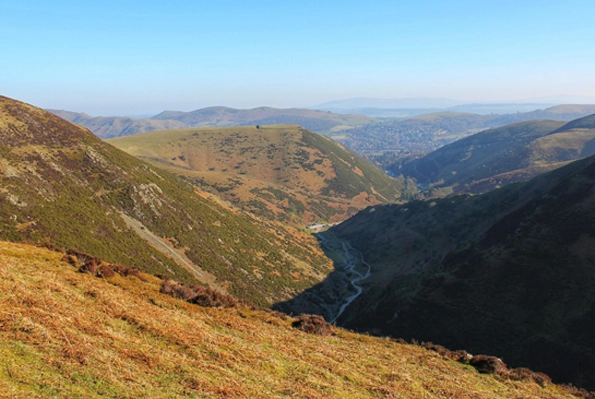The Long Mynd and Carding Mill Valley at Church Stretton, cover nearly 5,000 acres and are important places for wildlife, geology and archaeology; there are paths for walking, cycling and horse riding. From the summit of the Long Mynd you can see stunning views of the Shropshire Hills Area of Outstanding Beauty and the Welsh Hills as well. Carding Mill Valley has a bird hide, a stream for children to play in and a pond dip. Families can take a picnic but no barbeques or campfires are allowed; special permission is necessary to operate a drone and no overnight camping is permitted.
Whilst the Long Mynd is owned by the National Trust it is an area of Common Land cared for by a group of farmers, known as Commoners, who graze sheep and ponies. These ‘Common Rights’ have been passed from generation to generation for hundreds of years and were enshrined in law in Medieval Times; and whilst in the 17th century over 25% of England was Common Land now only 3% is registered as common land. Traditionally a swell as grazing horses, cattle, pigs and sheep other rights practiced include fishing, collecting wood and the harvesting of bracken. This collective grazing management has meant common land has for centuries been afforded a higher level of protection from intensification. Almost none has been ploughed which has resulted in the land being seven times more likely to be designated for nature; you are four times more likely to find an ancient monument on common land than in a field.
There is pollen evidence to show that trees began to be replaced by grass on the plateau of the Long Mynd from the Bronze Age, over 2,000 years ago, and there is written evidence of organised management, as a grazed common, from the 13th century. The Commoners’ ponies and sheep grazed here are hardy animals and are well adapted to the harsh conditions of life on the hill. They graze selectively and very close to the ground, leaving patches of long vegetation which benefits insects and small mammals. This grazing pattern has resulted in a special ecology and the Long Mynd Common is therefore designated as a Site of Special Scientific Interest. Livestock grazing plays an important role in maintaining species-rich habitats by controlling the more aggressive plant species which would otherwise dominate the area. The number of livestock and the timing of the grazing needs to be carefully managed so that the habitat continues to flourish.
Other than the boundary fence, which is largely maintained by the Commoners, there is no other fencing on the hill that restricts the movement of livestock, therefore to undertake routine husbandry tasks, commoners use dogs to gather their flocks together before driving them off the hill back to the farm; the sheep from each farm seem to know instinctively where their flock’s grazing boundary is. The ewes teach their lambs where the good grazing is, where to shelter and where to cross streams. Everyone is welcome to access all common land on foot but horse riders and cyclists are restricted to Bridleways only.
There is a short half-hour Pool Hollow Walk of half-a mile that takes you past the mill ponds and up the reservoir bank. For others there is the mile and a half, one to one and a half-hour walk, to Lightspout Waterfall. The Pipe Walk which takes one hour to cover one and a half miles combines these two walks,The Burway Loop, a five-mile walk takes two and a half hours to complete and takes you up to the highest point of the Long Mynd. All these walks start from the Chalet Pavilion in Carding Mill Valley. Finally, if you need something more challenging the Ratlinghope Ramble takes four to six hours to cover ten miles and takes you to the quieter western side of the hill; there is a pub half way round if you need refreshment!
To keep children interested on the walk play pooh-sticks if you cross a stream by a bridge; or each family member can choose a different colour and then see how many things you spot your colour in the plants and animals; or create your own “I Spy” list before you leave home. This could include such things as: a yellow flower, a feather, a butterfly or the mark of a horseshoe; and make sure you have a camera so that they can record their findings. If you have a dog with you don’t forget the lead and dog poo bag. Remember to leave no trace of your visit -taking your litter home.
